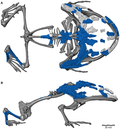Beelzebufo
Beelzebufo was a large frog discovered in the Upper Cretaceous of Madagascar. The media called it 'Devil Toad', and 'The Frog From Hell'. The frog lived some 70 million years ago.[1]
| Beelzebufo Temporal range: Upper Cretaceous, 70 mya
| |
|---|---|

| |
| Artist's version of Beelzebufo | |
| Scientific classification | |
| Kingdom: | |
| Phylum: | |
| Class: | |
| Order: | |
| Suborder: | |
| Family: | |
| Subfamily: | |
| Genus: | Beelzebufo Evans, Jones, & Krause, 2008
|
With a body length of about 16 inches (40.5 cm) the frog was larger than any living frog.[2] Its weight in life was about 9-10 lbs (4.5 kg).[3][4]
Relationships
The bones of the skull roof shows a rugous (wrinkled) external surface, indicating that at least parts of the head may have borne bony scutes.
The Beelzebufo was a member of the horned toad sub-family, the Ceratophryinae. Living members of the family are found only in South America, but were once more widely distributed in Gondwana. Both South America and Madagascar were part of the supercontinent Gondwana before it broke up in the Cretaceous.[1]
Habits
Beelzebufo was an ambush predator whose wide mouth let it eat relatively large prey, perhaps even juvenile dinosaurs.[3] It probably lived in warm, seasonally dry habitats with occasional pools of water. Its modern relatives live in similar habitats, and can burrow.[1]
Beelzebufo Media
References
- ↑ 1.0 1.1 1.2 Evans, S. E.; Jones, M. E. H.; Krause, D. W. (2008). "A giant frog with South American affinities from the late Cretaceous of Madagascar". Proceedings of the National Academy of Sciences of the United States of America. 105 (8): 2951–2956. Bibcode:2008PNAS..105.2951E. doi:10.1073/pnas.0707599105. PMC 2268566. PMID 18287076.
- ↑ The largest living species of frog, the Goliath frog, can grow to just over a foot in length (32 cms) in body length.
- ↑ 3.0 3.1 "'Frog from hell' fossil unearthed". BBC News. 2008-02-18. http://news.bbc.co.uk/2/hi/science/nature/7251666.stm. Retrieved 2008-02-18.
- ↑ "Devil Frogs, Devil Frog Pictures, Devil Frog Facts". Animals.nationalgeographic.com. 12 March 2010.

